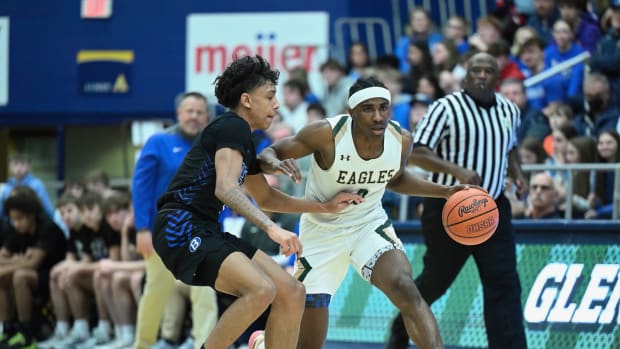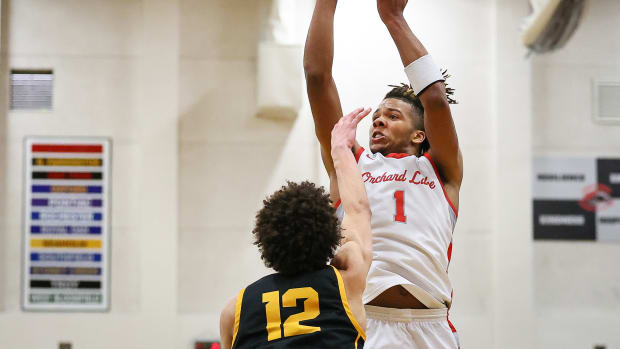WIAA equips referees with body cameras to combat bad behavior in Washington high school sports
RENTON, Wash. - As a former Vancouver-area basketball coach in southwest Washington, Mick Hoffman knows all too well about heated clashes with referees.
He even lost his mind a few times.
"I was emotional when I coached," he said.
But also as a former executive director of safety, transportation and athletics for Vancouver Public Schools - and now the top athletics and activities administrator in the state as the fifth-year WIAA executive director - Hoffman sees the other side of things.
Trends in poor sportsmanship - coach, player and spectator abuse of game officials - continue to rise nationally in high school athletics.
So, the WIAA and Washington Officials Association (WOA) decided to implement a thinking-outside-the-box strategy to curb the current mad-behavior craze.
They are giving referees the option to wear body cameras.
As part of the WIAA and WOA's eight-week pilot program, 100 basketball referees in 11 different counties statewide have been wearing them while they've officiated high-school varsity, junior varsity, 'C' team and middle-school games.
The pilot program ends after this weekend's regional round of the WIAA playoffs.
"We need to find a way to help people change their behavior," Hoffman said.
EJECTIONS, POOR SPORTSMANSHIP ON THE RISE
With the number of abuse-toward-referees incidents increasing - subsequently, the pool of game officials has decreased.
According to a 2023 National Association of Sports Officials (NASO) survey where nearly 36,000 referees across all sports were polled, more than half of the officials say they felt unsafe or feared for their safety at games in which they worked (up 5 percent since 2018 survey).
Approximately 68 percent of the referees deemed sportsmanship, at adult recreation, high school and youth levels, is getting worse (up 11 percent since 2018).
And 13 percent of game officials polled admitted they have been assaulted by a fan, coach or player (same as 2018).
Nearly 700 of the latest (NASO) survey participants were from Washington - and those national trends are consistent with what has been happening in the state, said WOA executive director Todd Stordahl.
"Ejections in Washington ... are not going down (700 last season). The reasons for the ejections are getting worse in terms of the behavior of kids and coaches and what they are saying to officials," Stordahl said. "It is completely unacceptable."
In recent years, the WIAA has increased the length of suspensions for coaches and players after an ejection. In some sports, the association has mandated sportsmanship-training programs for coaches. New measures have done little to reverse the problems.
So, one day last spring, Stordahl saw an article in a magazine about how body cameras were being utilized for the first time by soccer referees in English Football Association (FA) adult leagues - and that abusive behavior was down significantly once the trial began.
Stordahl immediately informed Hoffman and WIAA assistant executive director Justin Kesterson about what he read in the article, and there was immediate interest in the concept of it.
After holding a webinar with U.K.-based body-cam manufacturer Reveal Media, WOA officials met with them in person at the NASO summit last July in California to gauge interest in both parties striking an agreement.
In August, they worked out a deal for the WIAA to become the first U.S.-based athletics governing body to use Reveal’s KS4 camera in games.
"(Reveal) was looking at the high school market - and sports beyond soccer," Stordahl said.
For the pilot program, the WIAA purchased 50 body cameras at approximately $500 per item in cost (plus an additional software-management expense) - and Reveal Media donated another 50 cameras.
These are a different style of body cameras that Reveal Media designed 15 years for police forces in England, said Matthew Heptonstall, the company's strategic development executive in sports.
"The sports camera ... is lightweight, durable while also having the ability to upload footage via Wi-Fi," Heptonstall said.
Once 100 referees from some of the biggest officiating associations in the state, including Tacoma/Pierce County, Spokane County, Tri-Cities (Benton, Franklin), Clark County, Yakima County, Thurston County Kitsap County, volunteered for the WIAA's pilot program, body cameras were shipped to them directly in the first week of January.
Days later, they began being used in high-school and middle-school games.
In terms of wearing the apparatus, referees have a vest underneath their uniform where the camera magnetically attaches.
"The magnet is really, really strong," said Ross Parker, a member of the Tacoma/Pierce County association for 43 years. "I suppose somebody running by with his or her hands out could catch (the camera) and move it, but I have to yank at it for it to come off."
HOW THE BODY CAMERAS ARE USED
As far as how body cameras are administered by referees during the games, the WOA mandated strict guidelines on when they are turned on so subjects can see themselves on screen:
* They are supposed to be activated during any technical foul issued to a coach, player or fan.
* They are turned on during any type of discriminatory behavior.
* They are activated if a referee feels in danger in any threatening situation, on or off the court.
Coaches and players (team captains) are supposed to be alerted of these body-camera triggers by referees during pre-game meetings.
"What I like about (the body camera) is that it is constantly recording, but you are only required to capture those bad moments," said Steve Quick, a veteran referee in the Okanogan County association.
"The hardest part for me has been, in the heat of the moment, to remember to switch the camera on."
Despite the WIAA sending out preseason emails alerting schools about the pilot program, Parker and Quick admitted most of the coaches on-site have been "caught off guard" by the actual implementation of body cameras.
"Once we explained it all, they all mellowed out about it," Quick said.
John Kiley, the Olympia boys basketball coach, said he experienced a myriad of feelings about the usage of a body camera for the first time in one of his games - but ultimately drew one conclusion.
"If we are doing this, it's because it is needed - and we are at a point that it needs to be corrected in our society," Kiley said. "And if this helps an official feel more protected or policed, then I see it."
If a game incident exists, the raw footage cannot be edited by a referee, Stordahl said. It is uploaded post-game to the WOA's iCloud account.
Once the pilot program ends this weekend, the cameras will be collected - and reissued to referees in spring sports for baseball, softball and soccer, and officials in fall sports for football and soccer.
As far as data collected from the eight-week basketball season, the WIAA will release its findings at a June executive board meeting.
But Hoffman is encouraged by the preliminary results from games officiated by referees wearing body cameras.
"We've had very few incidents," Hoffman said.
"With these cameras, we are letting people know there is evidence now to hold them accountable for their actions."





